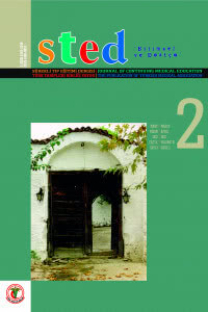Ria uygulaması öncesinde kadınların kaygı düzeyi
The anxiety levels of women prior to the application of ıntrauterine devices
___
- 1. Taşkın L. Doğum ve kadın sağlığı hemşireliği kitabı. 9.Baskı. Ankara: Sistem Ofset Matbaacılık; 2009; 585- 607
- 2. Akın L, Özaydın N, Aslan D. Türkiye'de evli erkeklerin aile planlaması yöntemlerini kullanmalarını etkileyen faktörler. Gülhane Tıp Dergisi 2006; 48: 63- 9.
- 3. Türkiye Nüfus ve Sağlık Araştırması 2008 Raporu. Hacettepe Üniversitesi Nüfus Etütleri Enstitüsü. Ankara: 2009.
- 4. Aksu H. Kontraseptif yöntemler. Kadın Sağlığı (ed: Şirin A.) Birinci Baskı. İstanbul: Bedray yayıncılık; 2008. s.309-12.
- 5.Birsen A, Kefeli B. Jinekolojik muayeneye gelen kadınların anksiyete düzeyi ve etkileyen bazı faktörler. Dokuz Eylül Üniversitesi Hemşirelik Yüksekokulu Elektronik Dergisi 2012; 5 (4): 134-141.
- 6. Aksakal O.S. Jinekolojik muayenenin psikososyal- medikal yönü. T Klin Jinekol Obst 2001; 11: 62-7.
- 7. Erbil N, Şenkul A, Sağlam Y. Ergül N. Jinekolojik muayene öncesinde Türk kadınların anksiyete seviyeleri ve muayeneye ilişkin tutumlarının belirlenmesi. Uluslararası İnsan Bilimleri Dergisi 2008; 5 (1):1-13.
- 8. Öner N, Le Compte A. Durumluk Sürekli Kaygı Envanteri El Kitabı, Boğaziçi Üniversitesi Yayınları; 1983 No 333.
- 9. Mayda AS, Arslan T, Bozkurt HB, Dedeli İ, Özkan MÖ. Düzce ili kalıcı konutlar bölgesinde 15-49 yaş arası kadınlarda yöntem kullanma oranları ve tercih nedenleri. TSK Koruyucu Hekimlik Bülteni 2005; 4 (5): 265-79.
- 10.Akın A. Aile planlaması, Temel Kadın Hastalıkları ve Doğum bilgisi, (Edt:Ayhan A, Duruhan T, Günalp S, Gürgan T, Önderoğlu L.S, Yaralı H, Yüce K) Ankara: Güneş tıp kitapevi; 2008. s.124
- 11.Ulusal aile planlaması hizmet rehberi, kontraseptif yöntemler, Sağlık Bakanlığı Ana Çocuk Sağlığı ve Aile Planlaması Genel Müdürlüğü. Ankara: 2000. s.456.
- 12.Tanrıverdi G, Özkan A, Şenveli S. Çanakkaledeki kadınların aile planlaması yöntemlerini tercih nedenleri. Fırat Tıp Dergisi 2008;13(4): 251-4.
- 13.Mete S, Jinekolojik muayeneye gelen kadınlarda oluşan anksiyeteye hemşirelik yaklaşımının etkisi, Cumhuriyet Üniversitesi Hemşirelik Yüksekokulu Dergisi 1998; 2 (2): 1-8.
- ISSN: 1300-0853
- Yayın Aralığı: 6
- Başlangıç: 1992
- Yayıncı: -
Gazlı içecekler: Sağlık Açısından değerlendirmeler
Elif BENDERLİOĞLU, DİLEK ASLAN
Ria uygulaması öncesinde kadınların kaygı düzeyi
BAHTIŞEN KARTAL, Aynur KIZILIRMAK, Hülya IŞIKÇI, Leyla AKÇAY, Kısmet AY
Fatih ÖZ, Arif Alper ÇEVİK, MEHMET ENES GÖKLER, ALAETTİN ÜNSAL
Bulaşıcı hastalıklar açısından sağlık çalışanlarının sağlığı
Aile sağlığı merkezinde çalışan sağlık personeline uygulanan sözel ve fiziksel şiddet sıklığı
